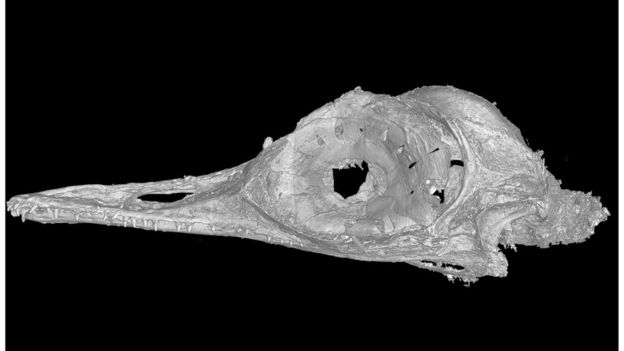In a major development, scientists have discovered what they say is the smallest known dinosaur. An entire dinosaur head trapped in amber, writes BBC Science Editor, Paul Rincon in an article published on the website.
What the fossil looks like?
The new species has been described by one team member as the “weirdest fossil” she has ever worked on.
The specimen, from northern Myanmar, consists of a bird-like skull trapped in 99-million-year-old amber.
Discovery To Enlighten Bird Evolution Theory?
Writing in the prestigious journal Nature, researchers report that the dinosaur would have been similar in size to the bee hummingbird – the tiniest living bird.
The stunning find may shed light on how small birds evolved from dinosaurs – which were often bigger.
While the smallest dinosaurs, such as the bird-like Microraptor, weighed hundreds of grams, the bee hummingbird weighs just 2g.
Why the small size?
The geographical location of the find might have something to do with the process of miniaturisation, say the scientists.
Isolation is often involved in animals evolving smaller body size, with some notable examples occurring on islands.
Interestingly, the amber from Myanmar is thought to have formed on an ancient island arc.
Challenges Of A Tiny Creature
“Animals that become very small have to deal with specific problems, like how to fit all sensory organs into a very small head, or how to maintain body heat,“ said Prof Jingmai O’Connor from the Chinese Academy of Sciences in Beijing.
 Image copyrightHAN ZHIXIN
Image copyrightHAN ZHIXINThe new species, dubbed Oculudentavis khaungraae, appears to have dealt with these challenges in unusual ways.
- For example, the animal’s eye structure surprised the scientists.
- Birds have a ring of bones, the scleral ring, that helps to support the eye. In most birds, the individual bones, called scleral ossicles, are simple and fairly square.
- But in Oculudentavis, they are spoon-shaped, a characteristic previously only found in some living lizards.
- The bones of the eye would have formed a cone, like the eye bones in owls. This indicates that the dinosaur had an exceptional vision.
What does this eye structure mean?
Unlike owls, the eyes faced sideways and the opening at the centre of the ossicles was narrow, which would have restricted the amount of light coming into the eye. This provides strong evidence that Oculudentavis was active in the daytime.
 Image copyrightLI GANG
Image copyrightLI GANGIn addition, the creature’s eyes would have bulged out of its head in a manner not seen in any other living animal, making it hard to understand exactly how the eyes functioned.
The Weirdest Fossil, A Bizzare Creature
“It’s the weirdest fossil I’ve ever been lucky enough to study,” Prof O’Connor explained. “I just love how natural selection ends up producing such bizarre forms. We are also super lucky this fossil survived to be discovered 99 million years later.”
Because the new specimen consists of only a skull, understanding how it is related to birds is unclear. Some features of the skull are like those of dinosaurs, while others are like those of very advanced birds.
How did it end up with these features?
The researchers say that the new specimen’s remarkable suite of traits could have evolved either through the constraints of miniaturisation, or through becoming specialised to a particular lifestyle.
The dinosaur’s jaw had a surprisingly large number of teeth. This would appear to suggest that, despite its tiny size, Oculudentavis was a predator that ate insects.
 Image copyrightHAN ZHIXIN
Image copyrightHAN ZHIXINSome soft tissue has also been preserved with the skull, notably the remains of the animal’s tongue, which could yield further insights into its biology.
What does this discovery mean for amber fossils?
The find highlights the incredible potential of amber to preserve fossil specimens that might not otherwise have survived.
Co-author Dr Luis Chiappe, from the Natural History Museum of Los Angeles County, said: “It’s lucky this tiny creature was preserved in amber, as such small, fragile animals aren’t common in the fossil record.
“This finding is exciting because it gives us a picture of the small animals that lived in a tropical forest during the age of dinosaurs.”
Did you subscribe to our daily newsletter?
It’s Free! Click here to Subscribe!
Source: BBC














